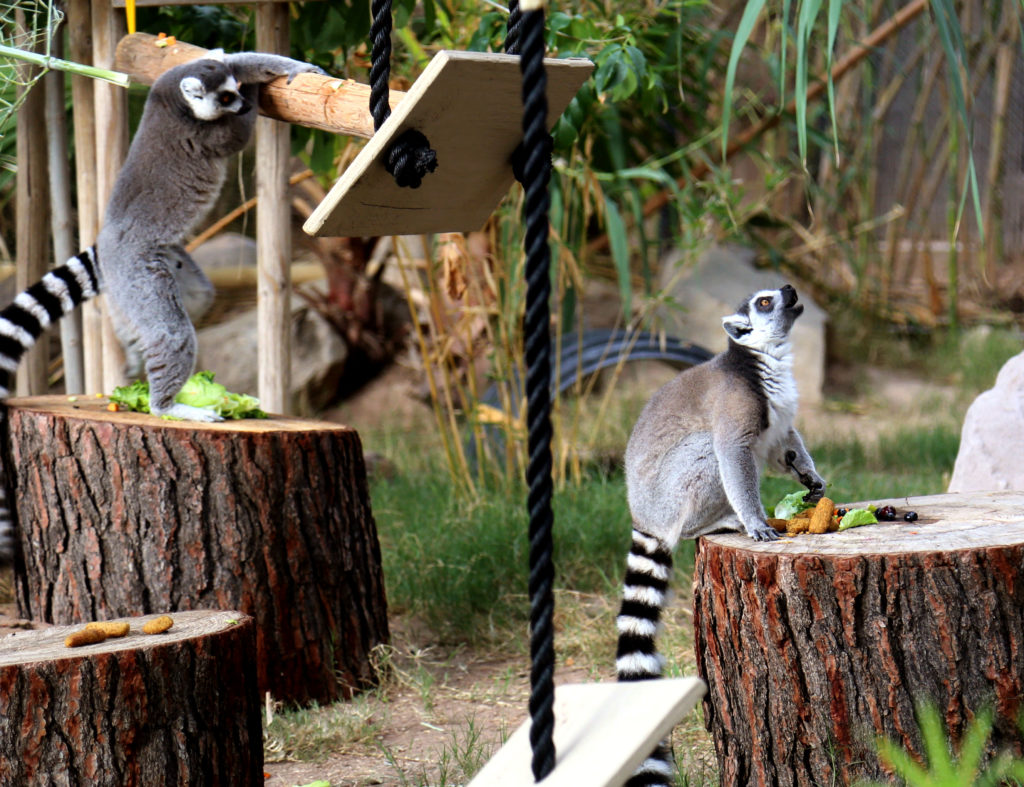In today’s society, animal welfare has become a growing concern, especially in relation to animals in captivity. Zoos, in particular, have come under scrutiny for their treatment of animals and their ability to provide a suitable environment for them. However, one aspect that cannot be overlooked is the role of zoo animal enrichment programs in promoting the well-being and cognitive abilities of captive animals. These programs strive to create an environment that mimics the natural habitats of animals and provides them with opportunities to engage in species-specific behaviors, stimulate their senses, and foster their mental health.
With the plethora of benefits that zoo animal enrichment programs offer, it is imperative to delve deeper into the topic to understand its significance in promoting animal welfare. This article aims to do just that, by exploring the various benefits of these programs and the ways in which they can improve the lives of captive animals.
1. Improved Physical Health

The physical health of animals is crucial for their overall well-being and longevity. In the wild, animals are constantly on the move, foraging for food and engaging in other activities that keep them physically active. However, in captivity, animals may not have the same opportunities to engage in such activities, leading to a sedentary lifestyle. This can have adverse effects on their physical health, resulting in obesity, muscle atrophy, and other health issues.
This is where zoo animal enrichment programs come in. By providing animals with opportunities for physical exercise, these programs help to promote their overall physical health. For instance, providing larger enclosures or adding climbing structures allows animals to move around and exercise their muscles. Similarly, activities like chasing a moving object or playing with toys can also help in keeping animals physically active.
Furthermore, these programs also help in reducing stress levels in animals, which can have a significant impact on their physical health. Studies have shown that animals in enriched environments have lower stress hormone levels and are less prone to illnesses. In fact, the American Association of Zoo Veterinarians recommends enrichment as an essential tool for maintaining the physical health of captive animals.
Examples of Enrichment Activities for Improved Physical Health
- Providing larger enclosures or adding climbing structures for animals to move around and exercise their muscles.
- Creating opportunities for animals to engage in natural behaviors such as foraging, chasing, and playing.
- Using puzzle feeders or hide-and-seek games to encourage physical activity while obtaining food.
2. Enhanced Psychological Well-being

Animal welfare is not just limited to physical health but also encompasses the psychological well-being of animals. In captivity, animals may experience boredom, frustration, and a lack of control over their environment, which can lead to negative impacts on their mental health. This is where zoo animal enrichment programs play a crucial role in promoting emotional well-being and reducing the risk of stereotypic behaviors.
Enrichment activities that provide animals with choice, control, and social interaction are particularly effective in enhancing their psychological well-being. According to a study by the University of Edinburgh, providing animals with choices and control over their environment leads to increased positive behaviors and reduced negative ones, such as pacing or self-mutilation. Social interaction through pair or group housing also helps to promote emotional health, as animals are social creatures and thrive on social interactions.
Moreover, enrichment activities that change daily or weekly help to keep animals mentally stimulated and prevent boredom. This can be achieved through introducing new objects, scents, or sounds into their environment, keeping them engaged and curious. By providing animals with the opportunity to engage in natural behaviors and have control over their surroundings, zoo animal enrichment programs greatly enhance their emotional well-being.
Examples of Enrichment Activities for Enhanced Psychological Well-being
- Providing animals with choices and control over their environment, such as letting them choose what object they want to play with or where they want to spend their time.
- Encouraging social interactions through pair or group housing for social species.
- Introducing new objects, scents, or sounds into the animals’ environment to keep them mentally stimulated and prevent boredom.
3. Increased Cognitive Stimulation
Just like humans, animals also have cognitive abilities that need to be stimulated to maintain their mental health. In the wild, animals are constantly using their brains to find food, build shelter, and navigate their surroundings. However, in captivity, these activities may not be as challenging, leading to a decline in cognitive abilities.
Zoo animal enrichment programs can provide animals with the necessary cognitive stimulation to keep their minds active and engaged. Puzzle feeders, interactive toys, and other enrichment devices can challenge animals to use their problem-solving skills to obtain food or solve puzzles. These activities mimic natural behaviors such as foraging, which is both mentally stimulating and rewarding for the animals.
Furthermore, enrichment activities can also help to reduce stress in animals, allowing them to use their brains for more productive purposes. Animals that are stressed tend to focus on finding ways to cope with their environment, leaving little room for other cognitive activities. By promoting a stress-free environment through enrichment, animals can use their cognitive abilities for more beneficial purposes.
Examples of Enrichment Activities for Increased Cognitive Stimulation
- Using puzzle feeders, interactive toys, and other enrichment devices that challenge animals to use their problem-solving skills.
- Providing opportunities for natural behaviors such as foraging and exploring.
- Creating a stress-free environment through enrichment activities, allowing animals to use their cognitive abilities more productively.
4. Facilitated Breeding
Breeding in captivity can be a challenging task, especially when animals are not in their natural habitats. Stress and a lack of appropriate environmental conditions can hinder breeding, resulting in low reproductive success rates. This is where zoo animal enrichment programs can help in facilitating breeding by providing a more conducive environment for animals.
Enriched environments create conditions that are more similar to the animals’ natural habitats, reducing stress levels and making them feel more comfortable. This, in turn, promotes natural behaviors, such as courtship rituals and mating behaviors, increasing the likelihood of successful breeding.
Furthermore, by providing opportunities for social interaction, enrichment activities also promote reproductive success. Social bonds are essential for animals to feel safe and secure, and when these bonds are formed, they are more likely to engage in mating behaviors. Enrichment activities that encourage social interactions, therefore, play a crucial role in facilitating breeding in captivity.
Examples of Enrichment Activities for Facilitated Breeding
- Creating an environment that mimics the animals’ natural habitat, reducing stress levels and promoting natural behaviors.
- Encouraging social interaction through pair or group housing for social species.
- Providing opportunities for courtship rituals and mating behaviors through enrichment activities.
5. Increased Visitor Engagement

Apart from the benefits that zoo animal enrichment programs offer for animals, they also have a significant impact on visitors. Enriched animals are more likely to exhibit natural behaviors, which provides visitors with a more enjoyable and educational experience. It allows them to observe animals in a more natural setting, leading to a better understanding and appreciation of these creatures.
Moreover, enriched animals are more active and engaging, making them more interesting and entertaining for visitors. This, in turn, leads to increased visitor satisfaction and may even encourage them to visit the zoo again in the future. By enhancing the visitor experience, zoo animal enrichment programs play a crucial role in promoting public awareness and education about animal welfare.
Examples of Enrichment Activities for Increased Visitor Engagement
- Providing opportunities for visitors to observe animals in a more natural setting.
- Encouraging natural behaviors that are interesting and entertaining for visitors.
- Helping to promote public awareness and education about animal welfare through enriched environments.
6. Case Studies: Successful Implementation of Zoo Animal Enrichment Programs
- The San Diego Zoo: The San Diego Zoo has been at the forefront of animal enrichment programs, providing its animals with a wide range of activities that cater to their physical, psychological, and cognitive needs. One notable example is their “Orangutan School,” where orangutans are taught skills such as painting, using tools, and even computer tasks. This not only keeps the animals mentally stimulated but also provides visitors with a unique experience.
- Disney’s Animal Kingdom: Disney’s Animal Kingdom in Florida has implemented various enrichment programs for their animals, including scent trails, feeding puzzles, and interactive toys. Their tigers have even been trained to paint with their paws, providing them with mental stimulation and reducing stress levels.
- Chester Zoo: Chester Zoo in the UK has implemented a highly successful enrichment program for their orangutans, which involves presenting them with puzzle feeders and other devices that require problem-solving skills. This has led to a significant reduction in stereotypic behaviors and improved overall well-being for the orangutans.
Conclusion
Zoo animal enrichment programs have become an integral part of promoting animal welfare in captivity. By providing opportunities for physical exercise, social interaction, and cognitive stimulation, these programs greatly enhance the lives of captive animals. They not only promote physical and emotional well-being but also facilitate breeding and provide visitors with an enjoyable and educational experience. Therefore, it is essential for zoos to prioritize the implementation of comprehensive enrichment programs to ensure the well-being and cognitive abilities of their animals are met.
wfriv.xyz